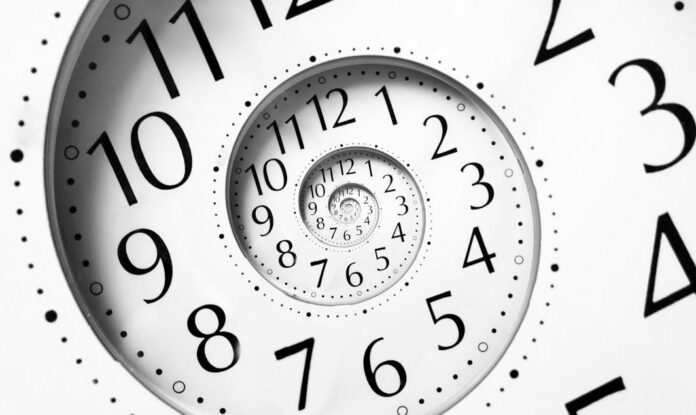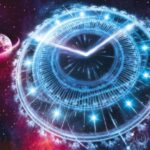Theories of science have ignored time… until now. A new idea reveals how it created the Universe – and you, writes Robert Matthews.
What exactly is the true nature of time? (Illustrator: Magictorch)
Time: it rules our lives, and we all wish we had more of it. Businesses make money out of it, and scientists can measure it with astonishing accuracy. Earlier this year, American researchers unveiled an atomic clock accurate to better than one second since the Big Bang 14 billion years ago.
But what, exactly, is time? Despite its familiarity, its ineffability has defied even the greatest thinkers. Over 1,600 years ago the philosopher Augustine of Hippo admitted defeat with words that still resonate: “If no-one asks me, I know what it is. If I wish to explain it to him who asks, I do not know.”
Yet according to theoretical physicist Lee Smolin, the time has come to grapple with this ancient conundrum: “Understanding the nature of time is the single most important problem facing science,” he says.
As one of the founders of the Perimeter Institute for Theoretical Physics in Ontario, Canada, which specialises in tackling fundamental questions in physics, Professor Smolin has spent more time pondering deep questions than most. So why does he think the nature of time is so important? Because, says Smolin, it is central to the success of attempts to understand reality itself.
To most people, this may sound a bit overblown. Since reality in all its forms, from the Big Bang to the Sunday roast, depends on time, isn’t it obvious that we should take time seriously? And didn’t scientists sort out its mysteries centuries ago?
Timeless physics
Prepare for a shock. Scientists have indeed tackled the mystery of time and reached an astounding conclusion. They insist that the most successful theories in physics prove that time does not exist.


But now Smolin has news for these scientists. He thinks they’ve been led to dismiss the reality of time by a mix of deep-seated beliefs and esoteric mathematics. And in a controversial new book Time Reborn, he sets out the dangers of persisting with this folly, and the promise of accepting time’s fundamental importance. If he’s right, it means far from being irrelevant, time is of crucial importance to explaining how the Universe works and is even responsible for our very existence.
Smolin is under no illusions about what he’s taking on. “The scientific case for time being an illusion is formidable,” he says. “The core of the case against time relies on the way we understand what a law of physics is.” He isn’t saying the laws are wrong, just that scientists don’t understand their true origins. “According to the standard view, everything that happens in the Universe is determined by laws,” he says. “Laws are absolute – they don’t change with time”. It’s this attribute that makes laws so powerful in predicting the future: plug in the Earth’s position today into the law of gravity, and it’ll give a pretty accurate location for its position a million years from now.
The laws also seem to reveal the true nature of time: “They suggest the flow of time is just a convenient illusion that can be replaced by computation,” says Smolin. In other words, time is just a trick that makes the equations spit out the right answers.
Emboldened by the seemingly limitless power of their laws and concept of time, physicists have sought to understand the properties of everything – including the Universe as a whole, in all its infinite majesty. But time and again, when they’ve attempted this, they’ve run into problems.
Over 300 years ago, Sir Isaac Newton tried to apply his law of universal gravity to the whole Universe, only to see it collapse when dealing with the infinite extent of space. A century ago, Albert Einstein applied his far more powerful theory of gravity, General Relativity, to the cosmos, but it broke down at the large scale – when explaining the Big Bang.
Quantum conundrum
In the mid-1960s, the American theorist John Wheeler and his collaborator Bryce DeWitt decided to see what insights might emerge from applying the most successful theory in all science – quantum theory – to the cosmos. Most often applied to the sub-atomic world, quantum theory can – in principle at least – be applied to everything, even the large-scale workings of the Universe.
Wheeler and DeWitt succeed in producing a nightmarishly complex equation that, according to quantum theory, captures the true nature of the Universe. But the equation spawned a shocking insight. Of all the quantities it contained, one that everyone expected it to include had simply vanished: ‘t’ for time. “According to the Wheeler-DeWitt equation, the quantum state of the Universe is just frozen,” says Smolin. “The quantum Universe is a Universe without change. It just simply is.”
The contrast with apparent reality could hardly be more stark. Astronomers insist the Universe began in a Big Bang and is still expanding. Stars are constantly being born and dying – along with ourselves. Clearly, something is wrong.
Many theorists have tried to find ways of getting what we perceive to be time to emerge from the ‘timeless’ Universe described by the Wheeler-DeWitt equation. “I’ve pondered these approaches”, says Smolin, “and I remain convinced none of them work.” He believes only a fundamental re-think about time can solve the crisis.
Not everyone agrees, however. Some insist that the Wheeler-DeWitt equation reveals the truth about time – no matter how unpalatable we find it. Chief among them is the British theoretical physicist Dr Julian Barbour, Visiting Professor at Oxford University. He has spent decades wrestling with the meaning of the Wheeler-DeWitt equation, and is renowned for his 1999 magnum opus The End Of Time.
Unlike Smolin, Barbour insists the Wheeler-DeWitt equation’s implication for time cannot be dismissed. He argues that the Universe is really a vast, static array of ‘nows’, like frames on some cosmic movie-reel. At any given moment, or ‘now’, time does not need to be factored in to explanations of how the Universe works. The sense of time passing comes from our minds processing each of these frames – or ‘time capsules’, as Barbour calls them. Time itself, however, doesn’t exist.
Smolin greatly admires Barbour’s efforts: “It’s the best thought-through approach to making sense of quantum cosmology,” he says. He has even incorporated some of Barbour’s latest ideas into his own. But he believes it suffers from the same flaws as all ‘timeless’ theories of the Universe: it struggles to make testable predictions, and it can’t explain where the timeless laws of physics come from in the first place.
Source and read more : Sciencefocus
Best Regards
TBU NEWS




